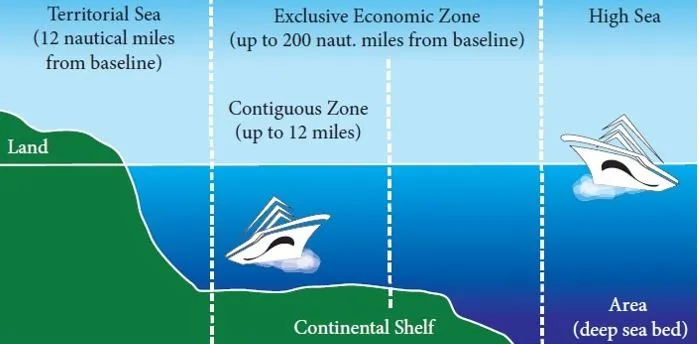

28th April 2025 (15 Topics)
Context
In a recent move, India has increased its claim over the Central Arabian Sea as part of its extended continental shelf. This new claim, covering approximately 10,000 square kilometers, is part of India's broader strategy to assert its rights over vast oceanic areas. India has also made modifications to avoid a longstanding maritime boundary dispute with Pakistan over the Sir Creek area.
What is the Continental Shelf and Extended Continental Shelf?
- The continental shelf refers to the shallow seabed surrounding a country's landmass that extends into the ocean.
- Countries can claim rights over their continental shelf and the resources beneath it. This includes the right to mine for minerals, polymetallic nodules, and extract oil reserves.
- Typically, a coastal country has an Exclusive Economic Zone (EEZ) extending up to 200 nautical miles from its coastline, within which it holds exclusive rights to exploit marine resources, such as fishing, mining, and oil exploration.
- An “exclusive economic zone,” or “EEZ” is an area of the ocean, generally extending 200 nautical miles (230 miles) beyond a nation's territorial sea, within which a coastal nation has jurisdiction over both living and nonliving resources.
- The concept of an exclusive economic zone (EEZ) was adopted through the 1982 United Nations Convention on the Law of the Sea.
- However, if a country’s continental shelf extends beyond this 200-nautical-mile zone, it can claim the extended continental shelf, provided it can scientifically demonstrate that the seabed extends naturally from its landmass to the ocean floor.
- Countries submit their claims for this extended shelf to a UN body called the Commission on the Limits of the Continental Shelf (CLCS), which evaluates the scientific data submitted to determine whether the claim is valid.

India’s Claims and Dispute with Pakistan
- India made its first submission for an extended continental shelf in 2009, which covered vast stretches of the Bay of Bengal, the Indian Ocean, and the Arabian Sea.
- As per these claims, India sought rights to valuable marine resources far beyond its original 200 nautical miles of EEZ.
- However, Pakistan raised objections to parts of India’s claim in the Western Arabian Sea.
- The main area of contention lies in the Sir Creek. Pakistan’s objections were formally lodged in 2021, and this led to the CLCS rejecting India’s original claim in the Arabian Sea in March 2023.
- The Commission, however, allowed India to submit modified claims to address the concerns raised by Pakistan.
- India’s revised claim includes an additional 10,000 square kilometers based on newly gathered data, expanding its total claim to an area roughly the size of India’s landmass—around 2 million square kilometers—almost doubling its existing EEZ.
Sir Creek
 |
More Articles

